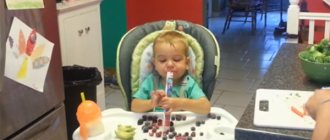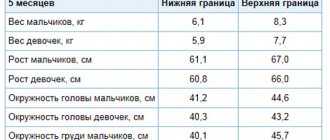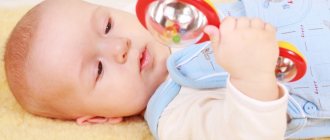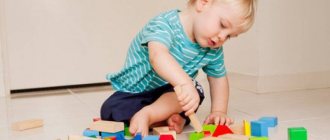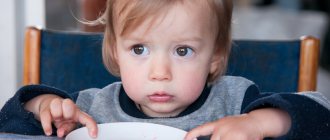Baby's height and weight
A baby's height at this age increases by 3 cm in 30 days, and weight increases by 800 g.
Table 1. Height, weight, chest and head circumference in children at 3 months (average values)
| Index | Gender of the child | |
| Boy | Girl | |
| Height, cm | 56 – 65,5 | 55 – 64 |
| Weight, kg | 4,5 – 7,5 | 4,4 – 6,5 |
| Chest circumference, cm | 36,5 – 43,8 | 36,2 – 42,8 |
| Head circumference, cm | 38,4 – 43,3 | 36,9 – 43,0 |
If a child has health problems (more serious than snot), his physical and mental development occurs on an individual basis (sometimes children have the indicated indicators per year).
If the baby is fed with mother's milk, the doctor should monitor whether breastfeeding meets his needs. Is full growth achieved and is weight increasing? This also applies to nutritional formula if the baby is prescribed artificial nutrition.
Motor skills
At 3 months of life, the quality and variety of movements of the baby improves significantly. What should a child be able to do at this age?
- Able to lie on his tummy, raise his torso, leaning on his elbows and forearms, raising his head high;
- Able to hold his head well in an upright position (in the arms of an adult);
- Able to sit with support from the pelvis, roll over from back to side.
At one year old, the baby should already be able to control his body in a more perfect way.
Child development at 3 months
Games at 3–4 months
Even at such an early age, you can start playing with your baby. This will teach him how to communicate and bring you even closer.
- Abracadabra. When your baby becomes most talkative, you also talk to him. Repeat the sounds after him and offer new ones.
- Airplane. The child is placed on your forearm and “flyed” around the room with him.
- Dancing. At this age, children love smooth, calm music. So turn on this one, take him in your arms and dance. A waltz would work well in this case.
- Let's go. Lay him on his back and use his legs to play some nursery rhyme. In this case, something like: “Big feet were walking along the road...” is appropriate.
- Exchanges of glances. Catch the baby's gaze. Then slowly bend your head to one side, then to the other. You will see, he will repeat the movements after you.
- Hide and seek. Throw a scarf over your face and say: “Where is mommy?” and taking it off say: “Here she is!”
- Take it away! Show your child the toy and get his attention. When he reaches for it, let him grab it tightly. Hold it in your hands and rock it until he grabs it.
Read: What does raising a 2-year-old child consist of?
It is best to use bright, contrastingly colored toys. You can use household items: spoons, towels, etc.
Visual and auditory perception
A 3-month-old baby continues to develop its visual and auditory analyzers and develops complex conditioned reflexes. When the baby spends time being awake and not sleeping, he begins to distinguish colors (at one year he will already be able to do this perfectly). He must fix his gaze on the object. Orientation in space and tracking of a sound stimulus while wakefulness lasts also arise at this stage. If a baby has snot and ARVI, then the development of skills is inhibited until recovery.
Table No. 2 will tell you what basic requirements a child’s hearing, vision and emotional sphere must meet at 3 months of age.:
| Skill | Characteristic |
| Visual orientation reactions | Visual concentration in a vertical position (on an adult’s face, a bright toy); Opening of the mouth when approaching the chest, at the sight of a bottle or spoon; He comes across toys hanging in the crib and learns to grab them if they are light in weight. |
| Sound-orienting reactions | Turns his head towards the source of the sound; Feels rhythm, distinguishes melodies (interested in musical toys) |
| Emotions and social behavior, speech development | The appearance of a “complex of emotional revival” in a child when talking with parents (smile, laughter, eye contact, active facial expressions); Recognizes mother; Expresses anxiety by screaming if he is left alone or the feeding schedule changes; The child begins to talk outside of sleep breaks, distinguishes the intonation of speech (at the age of one he will already use intonation himself). |
Nutrition
Most babies at 3 months are fed from their mother's breast. To feed some babies in the period of 1 month to 1 year of life, so that they gain weight, formulas are used exclusively, or they are used in combination with mother's milk. Therefore, the following types of feeding of children are distinguished:
- Natural feeding;
- Artificial feeding;
- Mixed feeding.
If parents adhere to the feeding schedule, then at this age the baby is advised to eat milk every 3.5 hours during the day. The nightly sleep break is 6 hours; you can give milk or a bottle of formula at night as required.
Waking during the day takes up more time in a child's life; sleep lasts from 1 to 1.5 hours between doses of milk or formula. Maintain proper drinking regimen (give water, juices). To help your child go to the toilet, use diapers.
From 3 months of age, breastfeeding can be supplemented with fruit juices. The mode of use depends on the individual child. Until the end of the day, the baby is allowed to eat no more than 30 ml of juice. It is offered after feeding with milk (a bottle of formula if artificial nutrition is indicated). The daily volume should be divided into 1-3 doses.
1-2 weeks after the introduction of the juice, the baby can be given fruit puree. Start with a very small amount and then gradually increase the dosage. The volume of puree that a child can eat throughout the day should be 10 g less than the volume of juice.
From 3.5 months of life, the baby can be given egg yolk. Pediatricians recommend this regimen for this product. Take 0.25 of one hard-boiled yolk, grind it with mother's milk and give it to the baby in the form of a suspension before feeding (with mother's milk, a bottle of formula if artificial nutrition is prescribed). By 4 months, the amount of yolk is increased.
When it comes to calculating whether breastfeeding or formula feeding meets the child's energy needs (if weight is not growing), the energy value of juice and puree is ignored.
A 3-month-old baby goes to the toilet a little less often than a newborn.
At one year old, the child already has enough regular food, so children refuse breastfeeding or formula.
Children for whom artificial feeding is chosen have the same feeding regimen as their peers. For such a child, special adapted formulas (starter formulas) are used, similar in composition to milk.
Baby development at 3 months
MAGAZINE Preschooler.RF
What should a child be able to do at 3–4 months?What can a child do? * child development, what a child can do, the development of a 4 month old child recognizes his mother (or a person constantly caring for him) and prefers him to everyone else; * recognizes the voices of familiar people and distinguishes them from strangers; * prints roulades, pronounces the first syllables; * grabs a hanging toy with one or two hands at the same time; * catches his name and reacts to it; * raises shoulders and head while lying on back; * reacts differently to familiar and unfamiliar things; * identifies “favorite” and “unfavorite” toys; * when feeding, plays with the breast or bottle, supports it.
When the baby turns 4 months old, life in the family becomes more orderly and calm. Perhaps by this time, caring for your child will have already become a familiar routine for you, although sometimes by the end of the day the baby begins to be capricious. Children who suffer from colic in the first months are already calmer at this age, and even restless babies allow moms and dads to sleep for six hours straight (though not always at night). From 4 months, a child’s tears and smiles are no longer reflexive, but quite meaningful. Babies don't just sleep or act out; every action has an emotional overtone. This is how children express complex feelings and their attitude towards others in the only way they can. In the first three months, the baby’s mood depended on the accumulation of gas or the desire to eat, as well as on the desire to attract the attention of adults. Now, at four months, the rapid development of the brain (and the corresponding improvement in the functioning of the digestive and nervous systems) allows the baby to show greater interest in the world and the events of “adult” life. At this age, a child may already experience fear, disappointment, curiosity and joy. A stable emotional connection with loving parents or people replacing them is a factor that ensures the normal mental and psychological development of a child. By 4 months, the baby has already learned to associate your image with pleasant sensations and care, so don’t be surprised when your baby’s lips stretch into a joyful smile when you appear. The close emotional connection that has formed between you and the baby is indicated by many signs: the baby smiles in response to your smile, begins to babble when you address him or stroke his head, and does not want to let you go anywhere. Funny sounds At 4 months, most babies “just don’t shut up”, you just need to learn to understand them. For example, a baby’s speech often begins with attempts to pronounce the open vowel sounds “a” and “o”. As a rule, the first things to come out of a baby’s mouth are the vague “p” and “b”, and, of course, every mother’s favorite “m,” so it may seem to you that the baby is saying “mom.” How can you know for sure that a child is gradually learning a language if he does not yet utter distinct words? And in this case, the main thing is relationships and emotional connection. It is not surprising that scientists talk about an increased ability to learn foreign languages in children with whom others talked a lot precisely during the period when the babies were 4-6 months old. Talk to your baby more often, tell him about the world and surrounding objects, and listen to what he answers you. It is not necessary to include language courses, audio fairy tales or engage him with educational toys; It’s enough to look at the pictures together and talk about what you see in them, tell your baby about your plans and events of the past day, show interesting objects when you go for a walk. Develop in your child a desire to imitate, especially speech. Listen carefully to your baby's humming: pick out your son or daughter's favorite sound and try to repeat it during the “monologue.” Join the child’s “conversation”, and after a while he will begin to repeat the sound after you. Introduce new sounds into your “conversations” (you need to take vowels first). Mastering the rollover, child development, what a child can do, child development 4 months To help the child learn (or train) to roll over on his side, place a large bright toy on the side of the crib. Move this toy further away so your baby has to reach for it. After the baby tries several times to reach the toy, move it closer to him. Tie a bell on a ribbon to the baby's arm or leg - the child will really like this and will allow him to feel his body better. At 4 months, the child learns to voluntarily grasp toys; At the same time, movements become clearer and more precise. The baby has “feelings”, he notices the appearance and disappearance of objects, their qualities (for example, heaviness), and is able to correlate the various properties of objects (optical, sound, etc.). The actions of the hands are still random in nature, without a targeted volitional effort. Infants begin to repeatedly attract a randomly grabbed object, followed by feeling and examining: now the baby examines the object with his lips and tongue, and can throw it in a certain place, for example, on the floor, to cause a sound. From 4 months, the child can already lie on his stomach, raising his body and leaning on the palms of his straightened arms. You can place flat foam pads (1-1.5 soi) under the child’s palms. For the pillow you need to choose a set of covers from fabrics of different colors and textures (flannel, silk, oilcloth, etc.). It would be nice to sew flat buttons of various shapes to the other side of the cover. Lying on his stomach and leaning on his forearms, the baby holds his palms on the surface of the pad. An adult takes the child's hand by the wrist and runs the baby's palm over the surface of the pad, trying to evoke palpating movements. Exercises with a ribbon and a cord are useful: when the baby lies on his back, an adult puts a smooth ribbon in his arms, and then a lace with knots. By carefully pulling the ribbon or cord at one end, the adult encourages the baby not only to grasp the object more tightly, but also to intercept it. Offer your baby objects of various shapes to grab (soft toys, large building blocks, rings of different diameters, etc.). Such exercises develop both fine motor skills and touch. Nursery games, development of a child, what a child can do, development of a 4-month-old child. The mother puts the child on the pillow, rhythmically throws it up, and then throws it off or rolls it down: * Carcasses, carcasses, sat on the pillow, * Girlfriends came, * Pushed off the pillow. * I’ll take my daughter (son) up a steep hill. *Boo! They rolled and fell down the hill. The child lies on his back, the mother first bends his legs in turn, then brings his arms together and spreads them: * The trampling legs went to thresh, * The rake arms turned up the hay. Bring the bent legs to the tummy, turn them on their sides: * Pushers - horns, oops! * Changelings! To drag oneself by the legs: * Let's go - let's go for salt, for salt. Mom taps on the baby’s heels in time with the nursery rhyme: * Kui, Kui, farrier, * Give me the boot, * For the little foot * Gold horseshoe. The mother strokes with her hand, and then with the baby’s hands, the named parts of the body: * Here is a forest (hair), * Here is a clearing (forehead), * Here is a hillock (nose), * Here the heart lives (put the child’s hand and let him listen to the heartbeat ). Theater of one mother In order for your baby to listen to poems and fairy tales with pleasure, they must be told vividly and emotionally. You can even create a small puppet theater using toys you have around the house. From 3-4 months, children watch with admiration small bright animals, each of which has its own voice, timbre and rhythm. In addition, in this way, kids learn to perceive and convey emotions, rejoicing with you at an outstretched turnip, crying over a broken testicle, crowing after the runaway Kolobok... Scientists have shown that children who were told poems from the first weeks later had no problems with memorizing large volumes of rhymed, rhythmic text (didn’t you suffer at school memorizing poetry?!). Their phonemic awareness was better developed and they were more receptive to foreign languages.
| Next > |
What are they?
- “What and where does it sound?”
Select interesting melodies and play them on the computer in the room next to the children's room. Or use a musical toy. Then you can take your daughter or son in your arms and together go look for what it sounds like. Speak out each action, praise the baby when you reach the source of the sound.
- “Catch the ring!”
Buy a ring (minimum weight) made of rubber, or take one of the rings from a children's pyramid. In a 3-month-old baby, when he remains awake, the hypertonicity of the muscles of the arms disappears, and their active growth occurs. He is already trying to grab something. You need to give the ring to the baby, saying “Take it,” then, with the intonation of a request, tell the baby to return it. After this, thank the young researcher.
- "Clever Girl and the Newspaper"
Under the supervision of an adult, you need to let the baby touch a sheet of paper, crumple it, and if possible, tear it into pieces. But remember that the baby should not taste the paper strips.
- “What am I like in the mirror?”
This game is played in front of a mirror. Stand or sit directly in front of him, holding the child in your arms. Describe what you see. You need to give names to body parts, then show different facial expressions.
Look in the mirror at the end of the day before your baby goes to sleep. Even before he turns one, the baby will be able to recognize his reflection. This is especially important if you are raising a girl.
Development of coordination
To help your baby develop coordination of movements and accelerate muscle growth, do the following exercises regularly (daily exercise, except when the baby has snot, etc.):
- Alternately raise and lower the baby’s legs, reciting a rhyme;
- Pull the baby by the arms towards you from a position where he is lying on his back so that his body is completely lifted off the surface. Then lower it slowly.
- Place baby's tummy on your lap. Fix her head and support her back, then start rocking your legs back and forth so that your baby feels like she's on a boat.
- In order for a baby to be able to roll over from his back to his stomach and back, as well as lie on his side, he needs the help of adults (the exercise regimen should be flexible; the baby’s height and weight do not matter). To do this, place your hand under the baby's shoulders and begin to lightly swing to the right and left. Then place the baby on its side and gently push it, encouraging it to roll over on its own.
The child will be interested in making movements to the music after the dream ends.
Development of thinking
Three months is the time when babies begin to play with rattles and learn to grab them. Choose a brightly colored rattle that has a long, thin handle. Bring it to the child's face and shake it several times. Make sure your baby responds to visual and sound stimuli.
To develop intelligence, exercises with a ball are suitable. Place the baby on his tummy. Place a colored ball in front of the baby's face, then you can start moving it in different directions. When the baby notices the toy, he will try to get to it.
Buy several bells that have different pitches. Alternately ring the bells from different ends of the crib. Then hide each one and watch as the child tries to determine the source of the sound and turns his head in the right direction.
Come up with a routine and lesson plan for the month and follow it exactly. The baby's growth and mental development will accelerate if he receives full maternal or artificial feeding. If you put in enough effort each day, you will be amazed at your child's progress when he turns one (it will be even easier to potty train your baby in the future).
Developing movement and tactile sensations
Nursing procedures also help the baby better navigate the world around him. Do not forget to pronounce each action, maintain eye contact with the baby during the time that takes natural or artificial feeding, bathing and walking. Buy a sufficient number of sensory toys that will stimulate the development of all the child’s perception systems.
- To develop tactile sensations, you can collect a collection of objects that have different surfaces - rough, smooth, with pimples, etc.
- You can make your own sensory book or panel by sewing pieces of different materials onto thick fabric and give it to your baby under supervision (you will also need it in the future, when your child is one year old).
- You can sew several pillow bags (should be light weight), inside which you can put fragrant plants and buttons (beads) of various shapes. Such toys stimulate the sense of touch and smell, and fine motor skills develop. Place them in the crib where the baby sleeps.
- You can place rubber toys next to your baby during the day that make a squeak when touched, and let the baby learn to play with them;
- You can choose several attractive rattles (some that are light in weight) to help your baby learn to hold objects. Place them in the baby's hands across the palm so that the thumb is separate from the rest.
Children of this age get tired quickly. For their development to be harmonious, they need regular sleep, natural or artificial feeding without delays. Present information in doses, control the duration of classes. Create an activity and rest schedule and strictly adhere to it.
Three months is a milestone in a child’s life when growth of all body systems occurs. During this period, the baby’s mental development is determined by contact with the mother (joint wakefulness during the day and sleep at night, breastfeeding or artificial feeding with a formula bottle). Every parent should be very attentive to the well-being and success of the baby. If there is any deviation in the baby's health, it is recommended to consult a doctor.
Baby development at 4 months
Swimming lessons
How to teach swimming without a circle?
At this age, the water temperature should not be higher than 35–36°C. In order for the baby to swim independently, various devices are used. The most modern is a swimming ring, which is attached to the neck. Help your child. Place your hand under your feet so that he pushes off (remember the “Crawling” exercise). Make raking movements with your hands.
You can teach swimming without a circle. In this case, several support techniques are used. “Bucket” support is when the mother holds her hand under the armpits, the child’s chin rests on her forearm. The arms are moved forward, the fingers are spread out.
Grasping with both hands under the armpits, so that the thumbs are on the shoulder blades, and the rest on the chest is called “girth from behind.”
If the mother is in the same bath, then she will be comfortable with “face to face” support: this is like an inverted form of “girth from behind”, the thumbs are on the chest, the rest are on the shoulder blades.
Classes begin with sliding and wiring. By placing the child with his back on his forearm, he is taught to float on the water, first holding him with his hands and gradually leaving him without support for a few seconds. Gradually increase time without parental hands. The “bicycle” exercise is connected to this skill so that he can push with his hands.
With the right approach to working with your child, you can achieve great results in the future. This is not only his physical development, but also a psychological component, since communication with the parent, especially with the mother, is simply necessary for the baby at this age.
Early development techniques in the following video:
09 Mar 2021 Valeria 378
Share this post
We recommend reading along with this article
- How to choose the right toys for babies
- What a 4 month old baby can do - description...
- Features of the development of a newborn child by week, stages...
- Feeding, sleeping, staying awake in the mode of a 2 month old baby
- The correct development of a one-month-old baby, what should be able to...
- What does the growth chart for a child up to one year tell you?
- How to make a children's room with a unique and inimitable design
- The age when babies begin to crawl, parental help, norms...
- How to develop a child at 4 years old physically and intellectually
Discussion: 3 comments
- Karina:
08/08/2019 at 03:15It is very important to talk with the child during this period, this contributes to the development of the baby’s speech, he will begin to talk faster. But for some reason some mothers ignore this process.
Answer
- Alevtina:
09/11/2019 at 09:14
I didn’t know what to play with a baby of such a young age, so I hung toys in the crib. I was involved in my daughter’s development at an older age, when the child had more understanding.
Answer
- Irina:
02/09/2020 at 15:46
At that age, our favorite toys were soft educational toys with rustling elements. The baby looked at them with pleasure, touched them and studied them as best he could. And for mom there was five minutes of freedom at this time)
Answer


